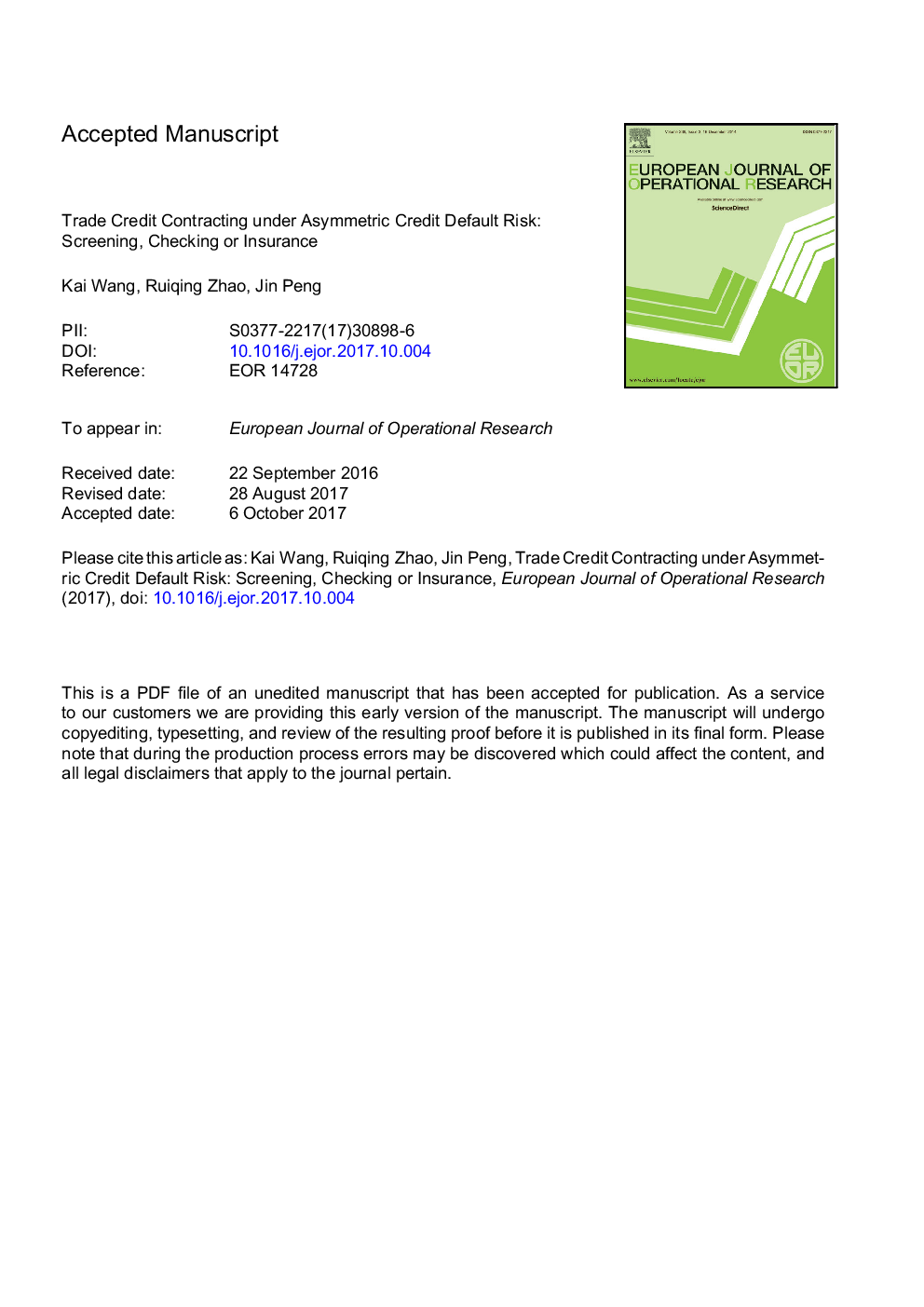| کد مقاله | کد نشریه | سال انتشار | مقاله انگلیسی | نسخه تمام متن |
|---|---|---|---|---|
| 6895168 | 1445938 | 2018 | 36 صفحه PDF | دانلود رایگان |
عنوان انگلیسی مقاله ISI
Trade credit contracting under asymmetric credit default risk: Screening, checking or insurance
ترجمه فارسی عنوان
قرارداد تجارت اعتباری تحت ریسک پیش فرض اعتبار نامتقارن: نمایش، چک یا بیمه
دانلود مقاله + سفارش ترجمه
دانلود مقاله ISI انگلیسی
رایگان برای ایرانیان
کلمات کلیدی
مدیریت زنجیره تامین، اعتبار تجاری، خطر پیشفرض، اطلاعات نامتقارن، طراحی مکانیسم،
ترجمه چکیده
اعتبار تجاری به سرعت در حال افزایش است و تبدیل به یک ابزار موثر برای انگیزه دادن به تامین کنندگان برای افزایش فروش و سود در مدیریت زنجیره تامین است. با این حال، اعطای اعتبار تجاری همچنین خطرات احتمالی تامین کنندگان را افزایش می دهد، به ویژه هنگامی که آنها با خرده فروشان با اطلاعات خصوصی درباره وضعیت اعتبار خود مواجه می شوند. در این مقاله، ما سه ساز و کاری رایج را که تامین کنندگان برای حل مشکلات پیش فرض اعتباری استفاده می کنند، بررسی می کنیم: چک کردن، چک کردن و مکانیزم های بیمه. تحت این مکانیسم ها، بر اساس اعتبار دوگانه تجاری، ما یک زنجیره تأمین کننده و فروشنده خرده فروشان را مدل می کنیم که در آن سطح اعتباری خرده فروش، بالا یا پایین، اطلاعات شخصی فروشنده است. ما متوجه می شویم که مصرف کمترین اعتبار نوع خرده فروش همیشه با کاهش دوره اعتبار تحت هر سه مکانیسم محدود می شود. در مقابل، برای خرده فروش اعتباری کم، تامین کننده خطر ابتلا به سرقت را به طور مستقیم از طریق خردهفروشی تحت مکانیزم غربالگری منعکس می کند، باعث تشویق خرده فروش به استفاده از مکانیزم چک و محدود کردن مصرف خرده فروش تحت مکانیزم بیمه می شود. علاوه بر این، بر خلاف شهود، ما نشان می دهیم که یک خرده فروش نوع اعتباری به طور منظم یک دوره اعتباری طولانی را از عرضه کننده به دست می آورد، زیرا خطر مربوط به یک دوره اعتباری طولانی می تواند به تدریج از طریق افزایش پرداخت اولیه به دلیل تاثیرات نظارتی اعتبار تجاری کاهش یابد. در نهایت، نتایج ما نشان می دهد که تامین کننده ترجیح می دهد از مکانیسم بیمه استفاده کند تنها زمانی که وضعیت اعتباری خرده فروش نسبتا فقیر باشد و یا مکانیزم غربالگری یا چک براساس پیش بینی خطای خطر پیش فرض در غیر این صورت، استفاده می کند.
موضوعات مرتبط
مهندسی و علوم پایه
مهندسی کامپیوتر
علوم کامپیوتر (عمومی)
چکیده انگلیسی
Trade credit has grown rapidly and become an effective tool to incentivize suppliers to increase sales and profits in supply chain management. However, granting trade credit also increases the suppliers' default risks, especially when they face retailers privileged with private information concerning their credit status. In this paper, we consider three common mechanisms that suppliers use to address credit default problems: the screening, checking and insurance mechanisms. Under these mechanisms, based on two-level trade credit, we model a supplier-retailer-customers supply chain, in which the retailer's credit level, either high or low, is the retailer's private information. We find that the high credit type retailer's consumption is always limited by reducing the credit period under all three mechanisms. In contrast, for the low credit type retailer, the supplier manages the default risk by directly forgoing some profits from the retailer under the screening mechanism, encouraging the retailer to consume under the checking mechanism, and restricting the retailer's consumption under the insurance mechanism. Additionally, contrary to intuition, we show that a low credit type retailer consistently obtains a longer credit period from the supplier since the corresponding risk of a longer credit period can be gradually decreased through an increased initial payment due to the regulating effect of trade credit. Finally, our results reveal that the supplier prefers to use the insurance mechanism only when the retailer's credit state is relatively poor and employs either the screening or checking mechanism based on the default risk gap effect otherwise.
ناشر
Database: Elsevier - ScienceDirect (ساینس دایرکت)
Journal: European Journal of Operational Research - Volume 266, Issue 2, 16 April 2018, Pages 554-568
Journal: European Journal of Operational Research - Volume 266, Issue 2, 16 April 2018, Pages 554-568
نویسندگان
Kai Wang, Ruiqing Zhao, Jin Peng,
